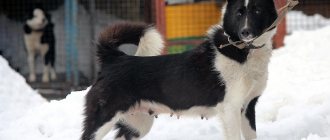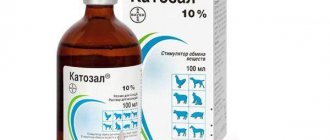General information
The active ingredient in neosidine is diminazene.
, a drug of the diamidine family used as an acetate salt. Diminazene has high activity against both trypanosomes and Babesia spp. This is also important in the treatment of theileriosis caused by Theileria annulata.
Diminazene has become the most commonly used therapeutic agent for trypanosomiasis in animals.
Antipyrine, which is part of the drug, ensures complete solubility of the active ingredient and helps fight inflammation and fever.
Pharmacological (biological) properties and effects
Combined antiprotozoal drug.
Diminazene diaceturate provides a wide spectrum of action, is active against pathogens:
- babesiosis
- nuttalliosis
- theileriosis
- trypanosomiasis
- Fransaiellosis
The mechanism of action of diminazene is associated with inhibition of aerobic glycolysis and DNA synthesis in protozoa, which leads to their death.
Phenazone has an anti-inflammatory effect.
After subcutaneous or intramuscular administration of the drug Neozidin®, the therapeutic concentration of diminazene in the blood plasma is achieved after 3-5 hours and is maintained for 24 hours. Accumulates in the kidneys and liver. Excreted in urine, in lactating animals - with milk.
Neozidine®, in terms of the degree of impact on the body, belongs to moderately hazardous substances (toxicity class 3); when used in doses according to the instructions for use, it does not have a sensitizing, embryotoxic or teratogenic effect.
Description and characteristics of the product
Manufacturers call Neosidine a reliable and fast remedy for getting rid of blood parasites. At the same time, the medicine brings other benefits to the animal. The drug is available in the form of a dry powder. Color: bright yellow. It quickly dissolves in water and is used in injection form.
Neosidine contains only two active components:
- Diminazene diaceturate. Inhibits the population of parasites of several subspecies. The substance disrupts the oxygen supply of microorganisms at the cellular level, paralyzes and destroys them. The compound also has an antibacterial effect and slows down the growth of fungal infections. Share in Neozidine - 55%.
- Antipyrine. High-quality analgesic and antipyretic biochemical compound. Reduces vascular permeability, eliminates swelling and hemorrhage. Quantity - 45%.
Neosidine is bottled in darkened glass bottles with an airtight seal. Their capacity is convenient for further dosing of the solution. The minimum mass of the powder is 1.18 g. Its weight in a larger container is a multiple of this number. Maximum - 23.6 g.
The veterinary drug is stored only in the manufacturer's packaging. Duration: 2 years from the date of manufacture. The storage procedure is standard for medications. Instructions for use recommend t 0…+25ºС. After opening the cap, the powder should be used within 24 hours.
The active substances reach their highest concentration in the body 3-5 hours after administration and remain for 1 day. Neosidine tends to be deposited in the liver and kidneys. Therefore, it is important to strictly adhere to the dosage from the instructions for use. The medicine is excreted in urine and milk (in lactating species).
Application procedure
Neosidine is used intramuscularly in the form of a 7% sterile solution.
Prepared in compliance with the rules of asepsis and antiseptics. Use water for injection or sterile saline solution as a solvent in the following ratios (Table 1):
Table 1 - Dilution of the drug, according to the instructions
| Neosidine® powder (g/bottle) | Solvent volume (ml) |
| 2,36 | 12,5 |
| 1,18 | 6,0 |
| 7,08 | 37,5 |
The prepared sterile solution should be stored in a closed bottle from the manufacturer, in a dark place at room temperature for no more than a day, in the refrigerator for no more than two days.
Neosidine 7% sterile solution is administered to animals once intramuscularly in the following doses (per 20 kg):
- for piroplasmosis, babesiosis, francaiellosis and nuttalliosis - 1 ml (3.5 mg diminazene/kg body weight);
- for theileriosis - 1.5 ml (5 mg diminazene/kg body weight);
- for trypanosomiasis - 2.2 ml (8 mg diminazene/kg body weight).
Before using Neosidine® in dogs, parenteral administration of an antihistamine is recommended according to the instructions.
Doses of the drug Neosidine depending on the weight of the animal are presented in Table 2 (according to the instructions for working with the drug).
Table 2 - Dose of Neosidine depending on the body weight of the animal
| Weight (kg) | Dose of diminazene per 1 kg of animal weight | ||
| 3.5 mg | 5.0 mg | 8.0 mg | |
| Volume of 7% Neosidine solution in ml | |||
| 10 | 0,5 | 0,8 | 1,1 |
| 20 | 1,0 | 1,5 | 2,2 |
| 50 | 2,5 | 3,5 | 5,7 |
| 100 | 5,0 | 7,0 | 11,5 |
| 150 | 7,5 | 11,0 | 17,0 |
| 200 | 10,0 | 14,0 | 23,0 |
| 250 | 12,5 | 18,0 | 28,5 |
| 300 | 15,0 | 21,5 | 34,0 |
| 350 | 17,5 | 25,0 | 40,0 |
| 400 | 20,0 | 29,0 | 46,0 |
| 500 | 25,0 | 36,0 | 57,0 |
Dosage for dogs
Neosidine, solution for injection. The dose for dogs is 3.5-8 mg per 1 kg of animal weight once, intramuscularly.
In cases where sick animals do not experience a decrease in temperature and improvement in general condition after the first administration of the drug, repeated administration of the drug is allowed 24 hours after the first administration in the same dose.
Along with neozidine, it is recommended that dogs use antihistamines in accordance with the instructions for use.
Purpose and dosage
A deep intramuscular route of administration of the drug must be provided.
The recommended dosage is 3.5 mg diminazene acetate per kg body weight per injection. Do not exceed a total dose of 4 mg of active ingredient for any large productive animal.
One injection is sufficient for treatment.
Note: In case of T. brucei infection, the dosage should be doubled. For resistant strains, the dose may be 8 mg diminazene acetate per kg body weight.
Neosidine
Advantages
Fast therapeutic effect - after 3 hours
Antipyretic and analgesic effect
Favorable cost of treatment
Description
A quick and reliable solution to the problem of blood parasites with a favorable course of treatment.
It is a yellow-orange sterile powder, highly soluble in water.
Neosidine is produced packaged in 2.36 g in hermetically sealed glass bottles.
Compound
1 g NEOSIDINE - 450 mg diminazene, 550 mg phenazone
Pharmacological properties
Neosidine has a wide spectrum of antiprotozoal action and is active against the pathogens of babesiosis, francaiellosis, trypanosomiasis, theileriosis and nuttalliosis, parasitizing animals.
The action of diminazene is based on the inhibition of aerobic glycolysis and DNA synthesis in blood parasites, which leads to the destruction of their cellular structure and death. Phenazone has anti-inflammatory and antipyretic effects, which helps reduce vascular permeability.
Neosidine is quickly absorbed from the injection site, distributed in the organs and tissues of the animal, reaching a maximum concentration 3-5 hours after injection, and is retained for 24 hours. It accumulates mainly in the kidneys and liver, is excreted from the body with urine, and in lactating animals - partially with milk.
Indications for use
Neosidine is used for cattle, sheep, horses and dogs for therapeutic and prophylactic purposes against babesiosis, piroplasmosis, francaiellosis, nuttalliosis, theileriosis, trypanosomiasis and mixed infestations intramuscularly in the form of a 7% (in terms of diminazene base) sterile aqueous solution.
Dosage and method of administration
To prepare an injection 7% solution, 12.5 ml of water for injection or saline is introduced into bottles with Neosidine powder 2.36 g and 14.5 ml of a ready-to-use drug is obtained. The prepared solution can be stored in the dark at room temperature for 24 hours or in the refrigerator for no more than 2 days. Boiling or heating the solution above 37oC is unacceptable.
For the treatment of babesiosis, piroplasmosis, francaiellosis and nuttalliosis, Neosidin solution is administered to animals once intramuscularly at a dose of 3.5 mg of diminazene per 1 kg of animal weight, which corresponds to 1 ml of 7% solution per 20 kg of animal weight.
For the treatment of theileriosis, Neosidine is used at a dose of 5 mg of diminazene per 1 kg (1.5 ml per 1 kg of body weight), and for trypanosomiasis T. brucei (Nagan's disease) - at a dose of 8 mg of diminazene per 1 kg of animal weight (2.2 ml per 20 kg of animal weight) (table).
Directions for use (doses)
In cases where in sick animals after the first administration of Neosidine the temperature does not decrease and the general condition does not improve, after 24 hours the drug can be re-administered in the same dose.
Sick animals, depending on their physiological state, are given rest and additionally prescribed symptomatic medications: cardiac medications, laxatives, vitamin and mineral preparations (E-selenium, etc.).
For prophylactic purposes, when one or more animals with signs of piroplasmosis are detected in the herd, or after moving animals to an area unfavorable for blood parasitic diseases, Neosidine is used once at a dose of 3.5 mg of diminazene per 1 kg of animal weight, if necessary, the injection is repeated at the same dose in 10-15 days. When using the drug Neosidine in recommended doses, side effects and complications, as a rule, are not observed. Some animals have very
In rare cases, a rapidly passing swelling at the injection site is observed.
When administering the drug in a volume exceeding 10 ml for cattle and 2.5 ml for small animals, due to a possible pain reaction, injections should be administered in several places
Restrictions Slaughter of animals for meat is permitted no earlier than 21 days after the last use of the drug. In case of forced slaughter of animals before the established deadline, the meat can be used as feed for fur-bearing animals. Milk from dairy cows must not be used for food purposes within 5 days after using the drug. After heat treatment, such milk can be used as animal feed.
Other information about the drug Neosidine
Neosidine is administered parenterally, primarily to dogs, for the treatment of babesiosis.
, African trypanosomiasis and, more recently, infections with Rangelia vitalii, an emerging protozoan pathogen of dogs from Brazil. Neosidine is not available in the United States. Resistance to diminazene has been described in Babesia gibsoni.
Although small animal formulations are not available, a powdered commercial formulation of the drug (Veriben) is reconstituted with sterile water to a concentration of 7 mg/ml and administered intramuscularly at a dose of 3 mg/kg diminazene diaceturate for a pharmacokinetic study in cats. The dose was well tolerated and neosidine was eliminated with a half-life of only 1.7 hours and a peak concentration of only 0.5 μg/ml. Development of clinically effective doses from these data requires further research. Neosidine was administered to seven cats experimentally infected with Trypanosoma evansi at a dose of 3.5 mg/kg intramuscularly for five consecutive days. The treatment was 85.7% effective in eliminating the parasite and no side effects were observed.
Effective doses of neosidine approach toxic doses
, so they should be used with caution.
Side effects include tachycardia and CNS signs such as ataxia, nystagmus, and opisthotonus. A single treatment may be prescribed or the dose may be repeated 72-96 hours after administration of the drug. In some protocols for B. gibsoni infections, administration of diminazene was followed every other day by treatment with imidocarb. ^Top
Indications and contraindications
The instructions for use allow the drug to be administered to cattle, pigs, horses, goats, sheep, cats and dogs for the treatment and prevention of:
- babesiosis;
- francaiellosis;
- trypanosomiasis;
- piroplasmosis;
- nuttalliosis;
- theileriosis and mixed infections.
Neosidine can cause a negative local reaction in the body: the formation of painful swelling at the point of skin puncture and an increase in body temperature. This effect is not considered a side effect and goes away on its own in 3-4 days. In dogs, a reaction to the active substances may manifest itself in muscle weakness, convulsions, and vomiting. These symptoms will also disappear and will not cause any significant harm to the animal.
The occurrence of a similar reaction when the drug is administered again indicates an individual intolerance to the components. Contact your veterinarian and ask him to prescribe a different remedy. Adverse reaction in case of Neosidine overdose:
- increased breathing;
- tremor;
- bradycardia;
- anorexia.
Advice. In this case, symptomatic therapy will help.











